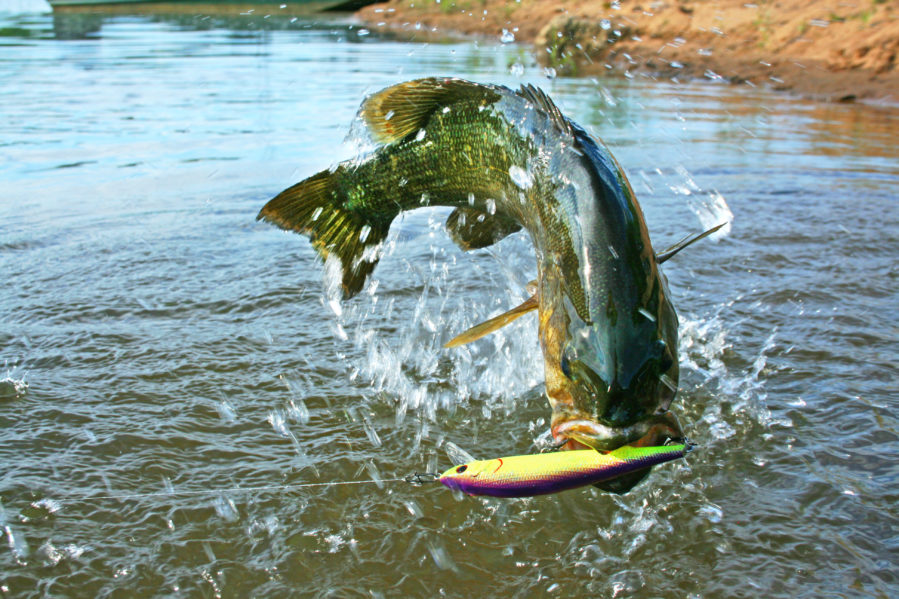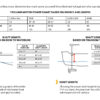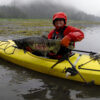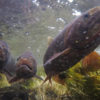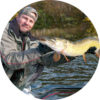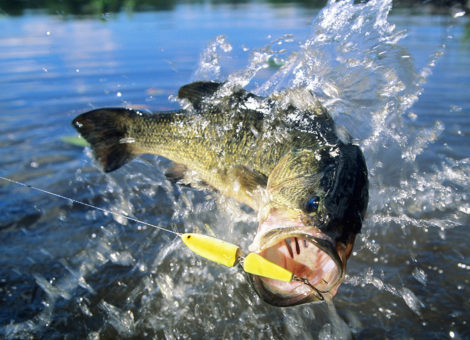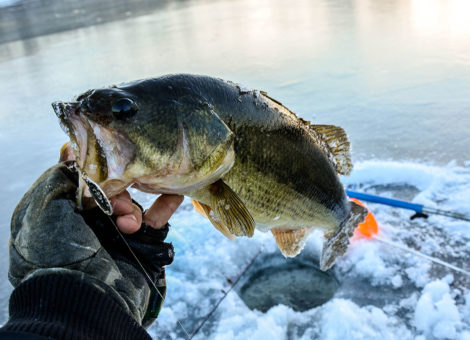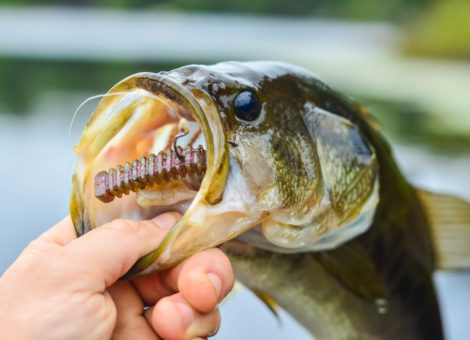When it comes to landing largemouth bass consistently, anglers need to know which bait or lure to use for the time of year, current weather, and water conditions. As well as the best techniques for presenting bait.
The following guide will introduce anglers to the most effective live baits and artificial lures that have proven time and again to increase catch rate and improve the probability of catching trophy largemouth bass more consistently, and in less time.
- Live Baits
- Artificial Baits
- Bass Fishing Lure Chart
- Best Largemouth Bass Baits for Spring
- Best Largemouth Bass Baits for Summer
- Best Largemouth Bass Baits for Fall
- Best Largemouth Bass Baits for Winter
- Best Bait for Catching Largemouth Bass in Clear Water
- Best Bait for Catching Largemouth Bass in During Spawning
- Best Bait for Catching Largemouth Bass in the Rain
- Conclusion
Live Baits
Most anglers know that using live bait is an effective method for catching largemouth bass. It requires less presentation from the angler in comparison to artificial lures and produces a higher strike rate.
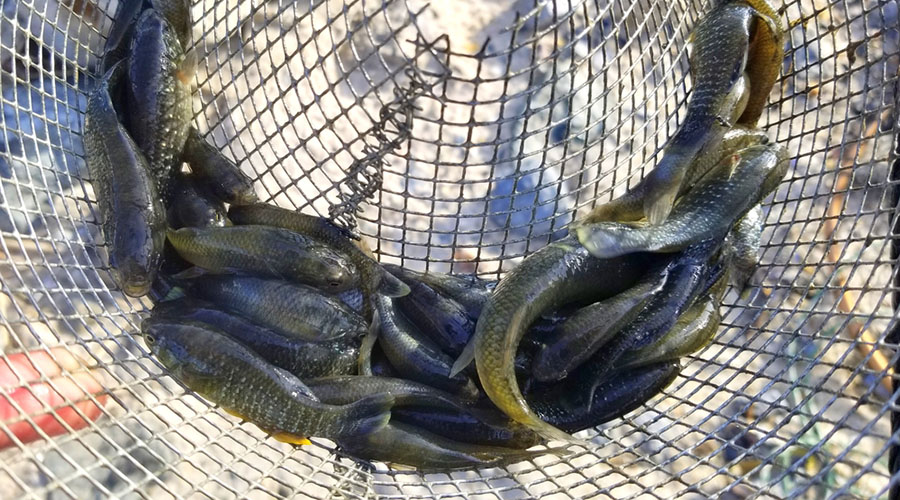
Largemouth bass are caught most frequently when using bait that resembles what they feed on in their natural environment. This is why baitfish and crawfish work so well for catching Largemouth bass — it’s what they usually eat. It’s also why experienced anglers prefer baitfish and crawfish over other types of lures. Other popular bass baits include frogs, worms, salamanders, bugs, larvae or even mice, depending on where you’re fishing.
Most live bait that mimics a bass’ natural food source will draw less scrutiny from the bass and require less presentation from the angler. As a rule of thumb, when selecting live bait, use whatever is found naturally in the waters where you’ll be fishing for largemouth bass. More often than not, a bass will not take a bait that they’ve never seen before. And for anglers, whose goal is to land a trophy bass, there’s no better option than live bait.
The following are the most popular live baits and presentation techniques used for catching largemouth bass.
Baitfish (Minnows, Shad, and Shiners)
Minnows, shad, and shiners are among the best live baits for catching largemouth bass. Baitfish can be small or large and can be used anywhere bass are found. However, they are particularly effective for targeting larger bass found in deeper waters.
There a variety of ways to rig and present a baitfish for targeting largemouth bass. The most common method for rigging a baitfish when fishing for largemouth bass is to run the hook through both lips from the bottom up. This method provides the most natural presentation in the water and usually doesn’t disfigure the bait itself. Baitfish can also be hooked through the back below the dorsal fin. Whichever method you use, you’ll want to do the least amount of damage to the baitfish as possible. If your live baitfish stops moving, you’ll need to replace it with a fresh baitfish.
An effective fishing method is to cast a shiner near vegetation, lily pad or other struture where largemouth hide, and wait for a strike. As soon as the bass strike, reel in the line. Anglers will often use a bobber with this method in order to keep the bait off the bottom of the lake and so they can see when the bass strikes.
Another common method to fish baitfish when targeting largemouth bass is to use a Drift fishing with an egg sinker and barrel swivel is also a preferred method to use for fishing shiners.
Crawfish
Depending on where you live, crawfish may also be known as crawdads or crayfish. Crawfish are an effective bait for largemouth bass. Some anglers would go as far as saying crawfish is the best live bait for catching largemouth bass. Their presentation is usually spot on and few hungry largemouths can resist them.
The best way to rig a crawfish is to run a hook up through the tail end of the crawfish and the back so that it can move through the water in a natural way. When baiting crawfish, use a hook that is proportionate to the size of the crustacean.
The best method for fishing crawfish is near rocks, vegetation, and other cover where largemouth bass are located. Simply drop the hooked crawfish in the water and allow it to move freely and present itself to waiting bass. Crawfish can also be drifted.
Worms
Bass fishing using live worms or nightcrawlers is a tried and true method that will almost always get a bite. It’s also a fun method for novice anglers and kids to excited about the sport. When rigging a worm, make sure the hook size is proportionate to the worm. Rig the hook through the tip and up the length of the worm trying to keep the hook covered while allowing the barb of the hook to protrude enough to hook the bass.
Nightcrawlers are usually fished near the shallows using lighter tackle. A common bass fishing setup is to use a light rod, a 6 lb. monofilament line, and a split shot rig with the worm hooked on the end. Jigging is also an effective method to present nightcrawlers when fishing for largemouths and other gamefish.
Frogs
Frogs are common in most ponds in North America and are a natural prey for largemouth bass. When choosing live bait for bass fishing, frogs are an excellent choice. Frogs work especially well anywhere there is heavy vegetation or dense cover. Frogs are not as easy to hook and fish as other types of live bait, but with a little practice even a novice angler can get the hang of it. The best way to rig a frog is to use a wide gap hook with a split shot weight positioned about a foot up the line from the hook. Passing the hook through the forelegs will ensure you don’t hinder the frog’s movement and allow it to move freely and naturally so it will attract bass.
Once the rig is complete, cast the frog near vegetation or other cover where bass can be found. The frog will typically swim to the bottom where it will catch the attention of feeding bass. If you don’t get a bite within a minute or two, make a small jerk motion with the rod. This will cause the frog to start moving again and attract the attention of nearby bass.
Artificial Baits
Largemouth bass are among the more aggressive gamefish and will readily take a variety of artificial baits and lures. The most effective artificial baits are those that mimic the natural prey of a bass. The more closely an artificial lure mimics natural prey the more effective it will be at attracting and catching bass.
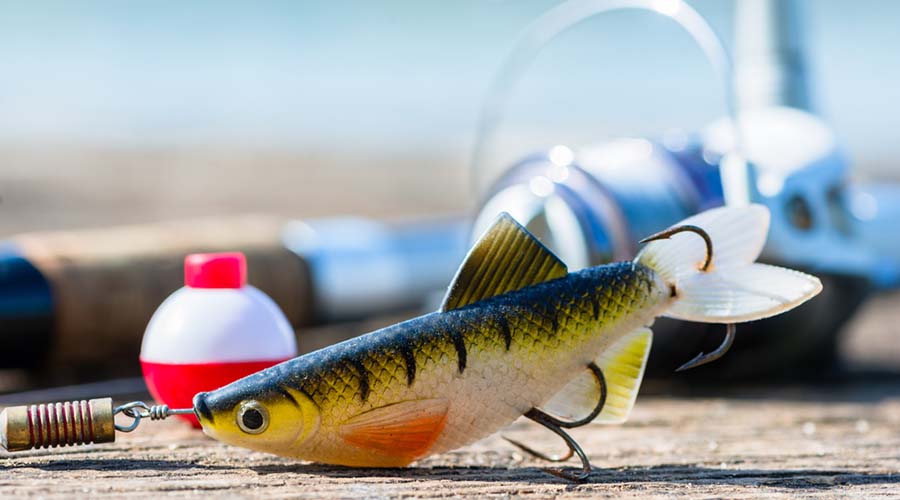
The most effective artificial baits for catching largemouth bass include the following.
Jigs
A jig is a weighted lure with a skirt. As the jig moves through the water column the skirt pulses creating the natural motion of baitfish and attracts the bass. Jigs are all around effective bass fishing lures that can be used year-round in both cool and warm weather. Jigs are a versatile lure that can be used in a variety of situations and environments, including heavy cover, deep water, drop offs and steep banks. If you’re not sure what lure to use based on conditions, start with jig. You usually can’t go wrong.
Crankbaits
Crankbaits are an artificial lure with a lip on front. The are designed to mimic baitfish. The lip causes the crankbait to wobble and dive through the water as it’s retrieved, mimicing the motion of a real baitfish. Crankbaits can be used in the shallows or fished deep. They can be used in just about any weather conditions.
Lipless crankbaits are the ideal choice to fish bass over deep points and grass flats during the late fall and winter when water temperatures are cold. During the late spring and summer, as water temperatures warm up, fish crankbaits over open water to target schooling bass.
Jerkbaits
Jerkbaits are a topwater lure fished on the water’s surface. As the angler jerks the rod, the jerkbait comes to life and attracts feeding bass. Jerkbaits are the perfect lure to use in cold, clear water. Jerkbaits mimic live bait and are ideal when bass are actively feeding. They can be used in various weather conditions and environments.
While jerkbaits can be used in a variety weather, they are an ideal cold water lure. Jerkbaits can be used during the spring and summer, but tend to outperform other lures during the late fall and winter. Jerkbaits should be fished by jerking the rod to create a sporadic motion. They should not be retreived too fast.
Plastic Worms
Plastic or rubber worms are one of the most popular artificial lures for fishing largemouth bass. They are extremely versatile and can be used in a variety of weather and water conditions. They can also be incorporated into a number of fishing rigs allowing them to be fished at all depths within the water column and target much more than just bass. Some of the more common rigs that use rubber worms include the Texas rig, Carolina rig and Drop shot rig. Plastic worms are simple, effective year-round, versatile, and most importantly, always catch bass.
When targeting largemouth bass in cold water, fish a plastic worm across the bottom using a Carolina rig. In warm weather, fish a plastic worm in the shallows near cover to improve the likelihood of getting a bite.
Plastic Prey Baits
In addition to plastic worms, there are a variety of plastic and rubber baits used to catch largemouth bass. Plastic baits should mimic the natural prey of largemouth bass. Some of the most effective rubber prey baits include plastic crawfish, rubber frogs, and rubber salamanders. Plastic prey baits can be rigged in a variety of ways to make them more effective in different environments and conditions.
Spinnerbaits
Spinnerbaits have one of more metal blades that spin like a propeller as they’re pulled through the water. The spinning blades flash as they reflect the light and also create a vibration that mimics a small baitfish. Spinnerbaits may also have a rubber skirt that flutters as the bait is pulled through the water adding to the appearance of a baitfish. The two most popular types of spinnerbaits include the in-line spinner and safety pin. A third, less popular spinnerbait, is the tail-spinner.
Spinnerbaits can be used in deep or shallow water, and in a variety of water conditions. They are most effective during the early morning and at night, but can be used at any time of day. Experienced anglers will often fish spinnerbaits over spawning beds during the spawning season to attract largemouth bass.
Spinnerbaits should be retrieved at a medium speed, not too fast, and not too slow. If a spinnerbait is reeled in too quickly, it will likely jump out of the water. When retrieved too slowly, the spinnerbait loses the appearance of a real baitfish and may be ignored by largemouth bass.
Swimbaits
Swimbaits exhibit a lifelike action that effectively mimics a live baitfish. As they’re retreived, they have a natural swimming action that provokes the predatory feeding instinct of largemouth bass. There are two categories of swimbaits: hard-body and soft-body. Hard-body swimbaits are made of wood or plastic. Soft-body swimbaits are made of rubber or soft plastic. In recent years, multi-jointed hard-body swimbaits have grown in popularity as they provide a more natural swimming appearance. Swimbaits can be fished at a variety of depths.
Given their life like appearance, swimbaits will evoke a reaction from largemouth bass during any time of the year, winter, spring or summer. During the winter, attaching swimbaits to an umbrella rig and then allowing them to fall through the water column gives the appearance of a dying baitfish and attracts opportunistic feeders. Anglers often use swimbaits on jigheads or weedless hooks depending on whether they’re fishing open water in heavy cover.
Swimbaits can provide several unique actions depending on the retrieve speed and style. Angler’s typically have the most success catching largemouth bass using a slow retrieval, which mimics the movement of a dying baitfish. When water is calmer, typically in the early morning or late evening, topwater swimbaits can be particularly effective for evoking a strike from largemouth bass.
There isn’t necessarily one best bait for catching largemouth bass. Selecting the most effective bait or lure is often a function of matching your bait to local conditions, including natural prey, water temperature, cover, season and spawning patterns. For example, during spawning season, summer mornings, and winter afternoons, largemouth bass are typically found closer to shore, and require a bait the works well in shallow waters. Trophy size largemouth bass are often found offshore, and require a bait that will perform in deeper waters.
Bass Fishing Lure Chart
The following chart will help you find the right bass fishing lure for a given season, water temperature, and water clarity.
| Season | Water Temperature | Clear Water | Muddy Water |
|---|---|---|---|
| Winter | 30-40° | jigs, jigging spoons, spinnerbait, grups | spinnerbait, jibs, crankbait |
| 40-50° | jigging spoons, finesse crankbaits, | shallow crankbait, square-bill crankbait, spinnerbait | |
| 50-60° | shallow crankbaits, spinnerbaits, jigs, jerkbaits , swimbaits | shallow crankbait, square-bill crankbait, spinnerbait, lipless crankbaits, creature baits | |
| Spring | 60-65° | crankbaits, lipless crankbaits, topwaters, jerkbaits, creatures, finesse jigs, spinnerbaits | spinnerbaits, crankbaits, soft plastics, jigs, buzzbaits |
| 65-70° | topwaters, crankbaits, jigs, spinnerbaits, creatures, frogs | jigs, plastics, frogs, buzzbaits, crankbait, spinnerbait | |
| Summer | 70-75° | shallow crankbaits, worms, spinnerbaits, jigs, buzzbaits, frogs, creature baits, topwaters | shallow crankbaits, spinnerbaits, soft plastics, jigs, buzzbaits |
| 70-80° | shallow crankbaits, worms, spinnerbaits, jigs, buzzbaits, frogs, creature baits, topwaters, drop shot rigs, jigging spoons, swimbaits | shallow crankbaits, spinnerbaits, soft plastics, jigs, buzzbaits, large soft plastics and worms, diving crankbaits | |
| Fall | 50° or below | jigging spoons, blade baits, slow rolled spinnerbaits, jerkbaits, lipless crankbaits | slow spinnerbaits, crankbaits |
| 50-60° | bladebaits, crankbaits, finesse crankbaits, buzzbaits, jigs, spinnerbaits, bladebaits, swimbaits | crankbaits, spinnerbaits, jibs, buzzbaits | |
| 60-70° | lipless crankbaits, spinnerbaits, shallow crankbaits, offshore jigs, blade baits | lipless crankbaits, crankbaits, spinner baits, buzzbaits, jigs, frogs, worms |
Generally, when waters cool off in the late fall and early winter, and largemouth bass become lethargic, anglers should use a slower retrieve. The best bass lures for fishing in cold waters include jigs, jerkbaits, spoons and swimbaits. During late spring and summer, as waters warm and bass become more active, they’re likely to bite at quicker moving lures and bait. The best bass lures for fishing in warm warmer waters include spinner baits, lipless crankbaits, skirted jigs, plastic worms and topwater frogs.
Below we’ll explore the best baits and lures for catching largemouth bass during each season of the year.
Best Largemouth Bass Baits for Spring
Early spring is fun yet challenging season to target largemouth bass. During the spring bass are migrating from the cold depths where they’ve spent the winter to warm, sunny shallows. The key to catching largemouth bass during the spring is find where they are and getting the right bait in front of them. Once you’ve caught your first largemouth, you’re likely to catch more.
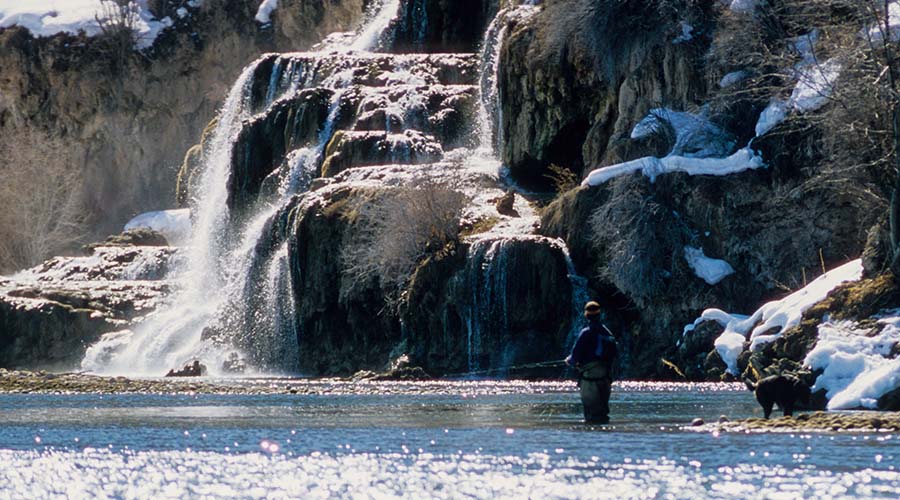
The most effective lures for fishing largemouth bass during the early spring are those that allow for a long cast and can cover plenty of territory. This is essential in order to find where the bass are at — especially in larger bodies of water. During the early spring, when bass are still moving slowly, lures with a slow presentation are preferable. As waters begin to warm in later spring, lures that provide more movement and support a quicker retrieve are ideal.
Suspending Jerkbaits
For colder spring days, suspending jerkbaits are an excellent choice. These lures mimic a fish that is dying from the harsh winter. Suspending jerkbaits, retrieved slowly, attract both hungry and lethargic spring bass. They’re most effective in clear water over drop offs, ridges and points near deep water, and spawning grounds. On cooler spring days, suspending jerkbait with a slow retrieve and slight rolling motion are the best choice. On warmer days, jerkbaits that provide more movement may perform better.
Lipless Crankbaits
Lipless crankbaits, like suspending jerkbaits, resemble a dying baitfish and are an excellent choice of lure for targeting largemouth bass during the early spring. Lipless crankbaits are ideal for areas with cover and vegetation as they can be reeled in above the vegetation and draw strikes from bass sheltering below. Lipless crankbaits are also ideal for finding largemouth bass since they can be cast long distances and cover a lot of water as they’re reeled in. On a slow retrieve, lipless crankbaits provide amble movement, vibration, and sound to attract a slow moving largemouth bass. Effective colors for lipless crankbaits are bright red and shiny chrome.
Jigs
Jigs are an all around effective lure for catching bass, even in the spring. Dropping a jig in the shallows along a dock, near rocks or other cover on a warm spring day is sure to get a strike from a hungry bass. Jigs allow long casts and can be retrieved slowly to cover a lot of area. They can also be used at just about any depth where largemouth bass are found. When targeting larger bass, larger jigs with creature-like lures — such as crawfish and grub — can be especially effective. Green crawfish lures are ideal for clear water, while brown, black, and orange tend to work well in darker muddy waters. When using a jig with a grub, a simple grub with a curly tail always seems to perform best.
Rubber Worms
You can’t go wrong with a small rubber or plastic worm. Plastic “finesse” worms, as they’re called, are effective for catching bass in the shallow flats where bass tend to congregate during the spring. The best plastic worms for fishing largemouth bass in the spring have a small profile and solid tail that doesn’t flap much when retrieved. Plastic worms are used in a variety of bass fishing rigs — including the Carolina rig, drop shot, and shaky head.
Tubes
Soft plastic tubes are a great lure to use during the late spring when largemouth bass can be found in flats and along ridges. Thoroughly run tubes along humps, close to the bottom, to find hungry bass. You’re sure to get a strike.
Best Largemouth Bass Baits for Summer
By summer bass fishing is in full swing. The sun is out, water temperatures are warmer, and bass are alert and active. They can now be found feeding throughout the water column. Smaller bass are often found in the shallows, while trophy size bass may still lurk in deeper waters. Their location will vary throughout the day and will be influenced by a number of factors including bottom structure, available cover, and weather. Consequently, it’s crucial to dedicate time to targeting bass in a variety of locations and get the right bait in front of them.
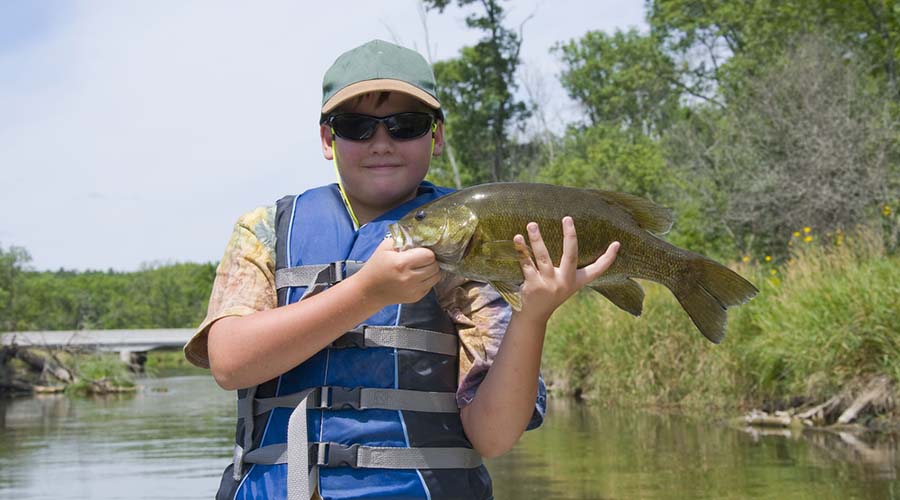
The following are some of the top performing largemouth bass baits for the warmer summer months.
Topwaters
It’s hard to find a bass lure that will outperform a topwater lure during mid-summer. These lures perform particularly well during the twilight hours of early morning, and the late evening around dusk as bass are feeding. Topwaters can be used in some of the toughest locations, including weedy shallows where bass love to hangout. Topwater lures also mimic the natural prey of largemouth bass including everything from flies to frogs.
There are a variety of topwater lures to choose from and a bass fisherman should have a good selection in their arsenal. Arguably one of the best topwater lures is the frog. Small frogs are natural prey of largemouth bass that like to hide under lilypads and vegetation ready to ambush. As largemouth bass react primarily to surface movement, most topwater lures that resemble the size of natural prey will evoke a strike.
Spinnerbaits
Spinnerbaits mimic a baitfish swimming through water. They also utilize vibration and flash to attract bass from a distance. They are a multi-species lure that work well for targeting active largemouth bass during the summer. There are a large variety of spinnerbaits each uniquely designed to provide a slightly different experience and reaction from feeding bass. Spinnerbaits can be used to target bass feeding on the surface or those deeper in the water column. However, they are more commonly used in the shallows where they can be pulled through vegetation without snagging.
Swim Jigs
As previous mentioned, jigs are an all season, all-around good lure for catching largemouth bass. Their versatility is unparalleled and there are many different styles of jigs on the market to choose from. The swim jig is one style in particular that evokes the predator instinct of a bass and will entice a powerful strike. Cast the swim jig over structure or in heavy cover then retrieve it as fast you can, taking breaks at intervals to allow the jig to fall before reeling again.
Crankbaits
We’d feel remiss if we didn’t include crankbaits on our list of top summertime bass fishing lures. Crankbaits are an effective lure year round, but they’re especially effective during the summer months while largemouth bass are highly active and aggressive. In a similar fashion to the Carolina rig, crankbaits allow an angler to cover a lot of area by trolling the lure across the bottom of the water. This combined with a long cast, allows the angler to get the crankbait in front of schools of hungry bass wherever they may be. When fishing deeper water during the summer months, opt for non-lipless style crankbait.
Plastic Worms
Toward the height of summertime heat and beginning of the end of peak feeding season, bass once again grow lethargic. During this time they may stop striking many of the popular lures already mentioned. The soft plastic worm can often entice a strike even when a bass is at it’s most docile state. From small finesse worms to large 10 inche twisting tail giants, there are a large variety of plastic bait worms available to anglers.
One of the most popular and effective presentations of a plastic worm lure is the the Texas rig. Here the angler places the hook through the worm with the point of the hook buried into the side of the plastic or slightly protruding parallel to the worm. This allows the angler to cast into the thickest vegetation and retrieve the lure while avoiding a snag. When the bass bites the lure the hook point will set hard in the mouth of the bass.
Best Largemouth Bass Baits for Fall
The transition from summer to fall is one of the trickiest times for catching largemouth bass. As summer cools down and the water gets colder, bass become more lethargic and finicky. They change their location and their feed patterns daily. The same lures and techniques that were catching largemouth bass just a few weeks early begin to wane in productivity. As fall approaches, savvy anglers change their tactics in order to stay at the top of their game.
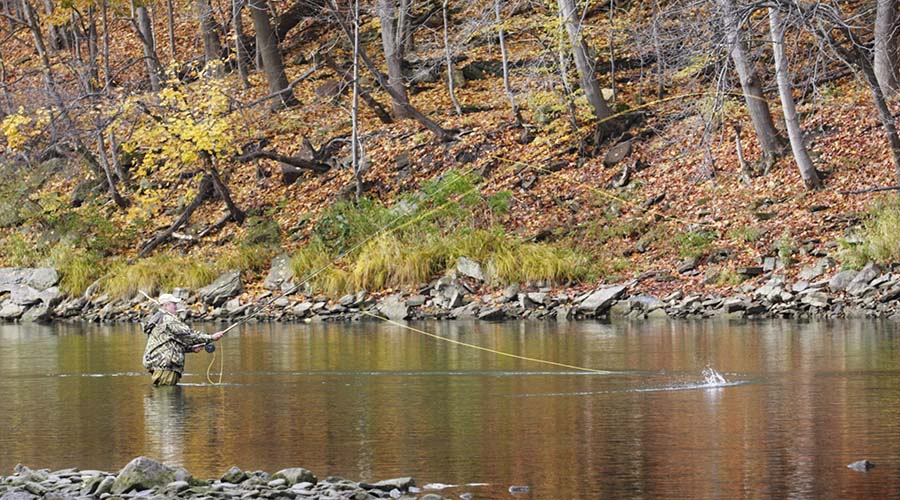
As fall weather becomes progressively colder and water temperatures drop, it becomes more difficult to find large numbers of bass congregating in the shallows. As winter approaches, bass begin migrating to deeper waters. This doesn’t mean you can’t catch a lot of bass during the fall, you certainly can. But it is increasely important you pay attention to where the bass are and use a bait they will strike.
The following are some of the best baits to use for fishing largemouth bass as weather cools.
Crankbaits
We’ve said it before, and we’ll say it again. Crankbaits work. Not only are they a good bass bait year round, they work well during the fall as water temperatures begin to drop off. During the fall most baits need to be fished deeper and slower. With a good crankbait, largemouth bass will strick a fast moving crankbait even in the shallows. Some anglers recommend using a square bill crankbait that will bounce off wood and rocks and trigger a bass to bite. If you’re going to fish deeper water, select a crankbait that will dive down to where bass are hiding in the cover. To catch bass migrating from the shallows out to deeper water, a medium-diving crankbait is ideal.
Spinnerbaits
When fished with enough finesse, spinnerbaits consistently produce strikes throughout the fall. As long as bass are not entirely sluggish, a spinnerbait will typically produce good results. For best results during the fall, spinnerbaits should be fished a little slower along structure and cover where largemouth bass are found.
Swimbaits
Swimbaits are a good alternative to spinnerbaits when water is particularly clear. The key to fishing swimbaits is matching it to the local baitfish that bass prey on. Luckily, swimbaits come in a large variety of sizes and colors making it easy for anglers to match a swimbait to the natural prey of a bass.
Jigs
When spinnerbaits and swimbaits just aren’t getting a bite, give a jig a try. Jigs will catch both active and less active largemouth bass throughout the fall and well into the winter. Drop a 1/4 to 3/8-ounce jib near a favorite bass hiding place (dock, rocks or other cover) and retrieve a steady pace twitching the line occassionally and you’re sure to get a bite. During colder fall months when bass can be particularly sluggish, a finesse jig tipped with a flipping tube will often do the trick. Allow the jig to fall through the water column to the bottom. The flipping tube will slow the descent of the lure. Retrieve and drop the jig several times. If you don’t get a bite, move to a new location and try again.
Best Largemouth Bass Baits for Winter
Winter is when bass are at their most sluggish, and there’s no doubt that bass fishing in the winter is little more challenging. But that’s no reason you still can’t catch a trophy largemouth. When the water temperatures dip below 50 degrees, it becomes more important than ever to use the right lure with the right presentation.
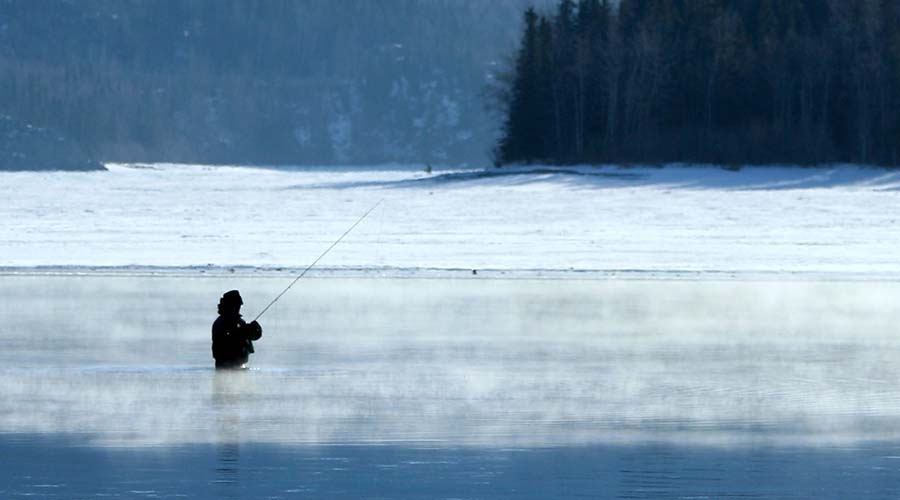
Jerkbaits
As long as they are feeding, bass will typically strike a jerkbait no matter how cold the water temperature. When water is clear, jerkbait can be fished from the bottom up to the mid-water column. If a bottom dwelling bass sees an attractive jerkbait, they will typically come up a few feet to strike. When fishing jerkbait in cold water, target structures (channel-swink banks, bluff ends, drains) that offer the opportunity for vertical rather than horizontal movement.
Jigs
“Winter, spring, summer or fall, all you have to do is…” use a jig. A good jig, with the right presentation, will get a largemouth bass to bite, even in the dead of winter. Some of the more popular jigs for targeting largemouth bass during the winter include finesse jigs, ball-head jigs and football jigs. Some professional anglers prefer the heavier football jig because it provides more options. The football jig easily maneuvers rock cover and it can be fished at just about any depth from 2 to 50 feet down. Slowly fish a jig around bass cover and you’re sure to get a bite.
Spinnerbaits
Have we mentioned that spinnerbaits are a good bass fishing bait? Well, let me say it again, spinnerbaits are great for catching bass — yes, even in the winter. Spinnerbaits are so great because they can be used in clear water or the muddy water which is common during the winter. Spinnerbaits are also quite versatile. They can be bounced off the bottom, yo-yo’d up and down in the water column or fished near the surface. Blade baits tend to be the most effective when water temperatures reach their coldest.
Crankbaits
Crankbaits are another staple lure that seasoned cold-water anglers rely on to catch largemouth bass in the coldest water temperatures. During times when water is at its coldest, use a lipless crankbait over deep points and dying grass flats to get a bass to bite. A light crankbait, like a Shad Rap, with light line and a light action rod is an ideal setup for catching bass all winter long.
There are several other lures, such as swimbaits, that will catch largemouth bass during the winter, but if you rely on the four lures mentioned above, you can’t go wrong.
Best Bait for Catching Largemouth Bass in the Rain
Who goes fishing for largemouth bass in the rain? Anglers who want to catch largemouth bass. For some anglers, fishing in the rain is taboo. It certainly should be if you’re fishing on the water in a lightning storm (and it’s not recommended.) But if you’re staying off the water simply because you don’t think bass bite while it’s raining, think again. Fishing for bass in the rain can be quite effective.
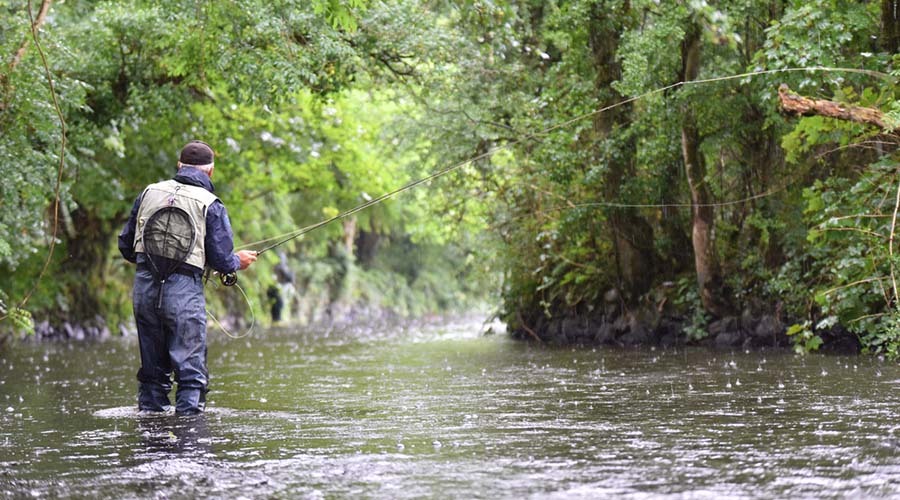
The best strategy for catching largemouth bass while it’s raining is to fish topwater lures or near-surface lures. Pitch a buzzbait or jitterbug on open waters in the rain near dense vegetation where bass hide and you might be surprised at the reaction.
The best baits for fishing largemouth bass in the rain include the following:
Spinnerbaits
Spinnerbaits are hands down the best lure to target bass in the rain. Choose a lure slightly lighter than what you’d usually use and work it quickly.
Topwater Frogs
Topwater frogs work great with or without rain, but they’re one of the few lures that performs well when the waters coming down. Frogs should be worked around weed beds, vegetation and dense cover.
Worms
Plastic worms are a solid choice of lure for targeting largemouth base in the rain. They’re versatile, can be worked quickly and can be presented in variety of ways. Rigging a worm using a Texas rig and casting it into the weeds or a Wacky rig and letting it dangle in the water are both great strategies for getting a largemouth bass to strike.
Best Bait for Catching Largemouth Bass in Clear Water
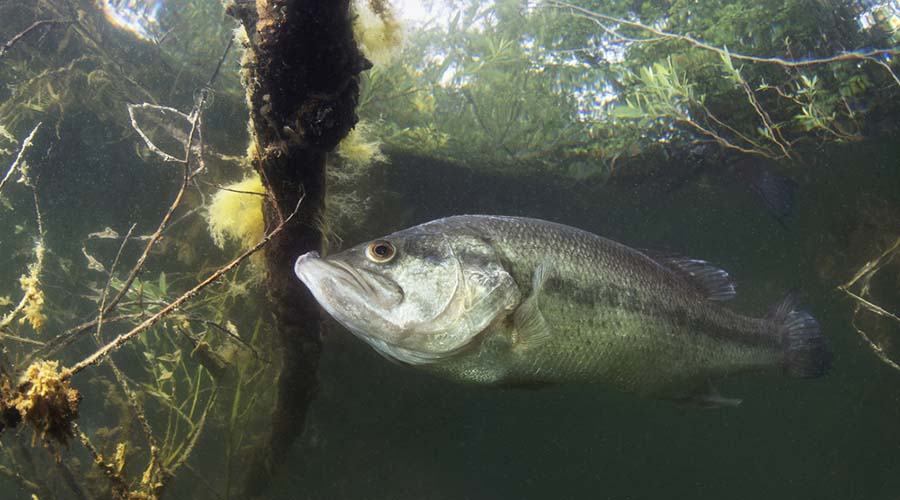
Sometimes the increased visibility provided by clear water can make it harder to convince a bass to take your bait. When targeting largemouth bass in clear water, it’s crucial that lures look natural and closely mimic the baitfish bass are accustomed to.
When bass fishing in waters with high visibility, baits should:
- be the same color as the bass’ natural prey
- be the same size as the bass’ natural prey
- closely mimic the natural movement of the bass’ prey
The following are lures and baits recommended for catching largemouth bass in clear water.
Jigs
Jigs, finesse jigs specifically, are ideal lures for targeting largemouth bass in clear water. Finesse jigs work well in lakes with smaller baitfish, as finesse jigs mimic smaller baitfish. In high-pressure lakes, and lakes with crawfish, finesse jigs seem to get the job done.
Softbaits
Softbaits are versatile and mimic the natural movement of prey fish. They can be rigged in a variety of ways, allowing an angler to test a variety of fishing styles and presentations. Common softbaits for fishing high visibility water include senkos and craw baits.
Swimbaits
Swimbaits usually do an excellent job mimicing a bass’ natural prey. Swimbaits can effectively mimic minnows, bluegill, or shad. These lures are ideal for fishing deeper waters and lakes with larger prey fish.
Lure color can also affect strike rate when fishing in clear water. The best lure colors for largemouth bass tend to be green, brown and shad in that order. Over half of anglers surveyed report that green exhibits the highest strike and catch rate in clear water conditions.
Best Bait for Largemouth Bass During Spawning
During spawning season, bass typically aren’t actively feeding. For a time, their predatory instinct turns into paternal instinct. While largemouth bass will still strike while spawning, it’s a different type of strike — it’s a protective strike. The goal while largemouth bass are spawning is to evoke a reaction strike.
Some of the best baits to entice a strike from a spawning largemouth bass include:
- Spinnerbait with a trailer hook
- Buzzbaits
- Frogs
- Live bait
- Crankbaits
Each of the above lures and baits will evoke a reaction from a spawning largemouth bass and entice a strike. Sometimes a spawning bass will bite due to hunger, but most often a strike is the result of the protective instinct. The key to catching largemouth bass is simply to evoke any type of strike.
Conclusion
While there are a number of excellent largemouth bass fishing baits and lures, there is no one best bait for catching largemouth bass. The best largemouth bass bait is the one that evokes a reaction and entices a bite.
Consistently getting bass to bite often requires a specific bait or lure depending on various factors, such as season, weather, water conditions, and how well a lure mimics a bass’ natural prey. Want to increase your strike rate and catch more largemouth bass? Then put yourself in the bass’ shoes for just a moment before making your lure selection.


